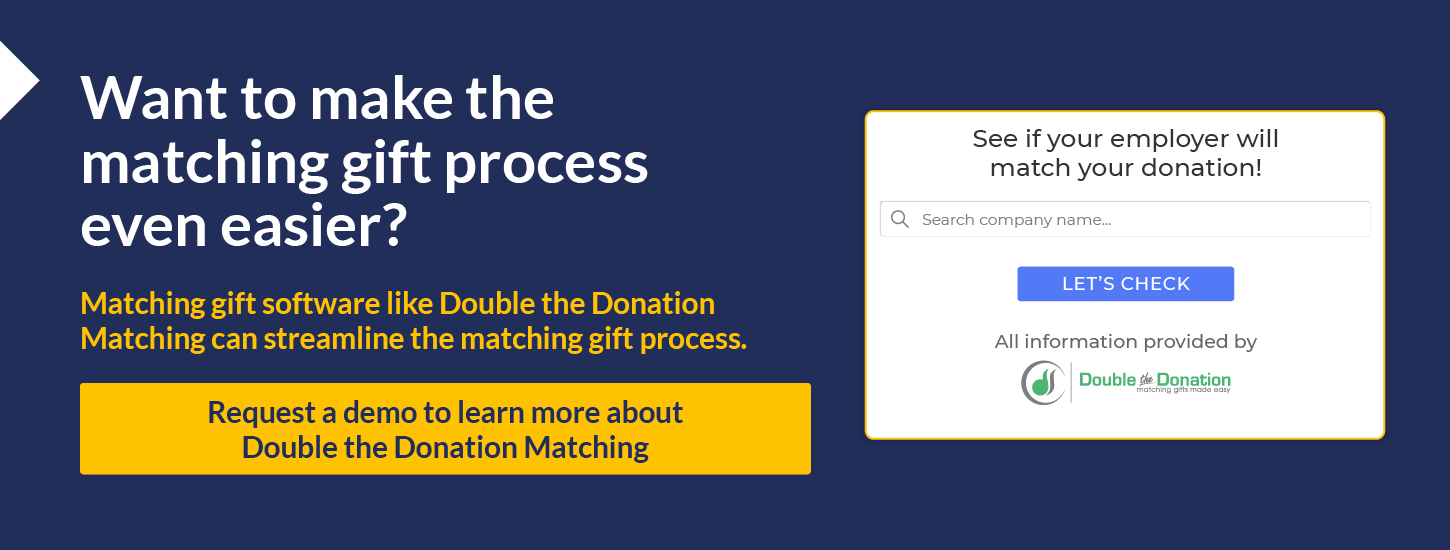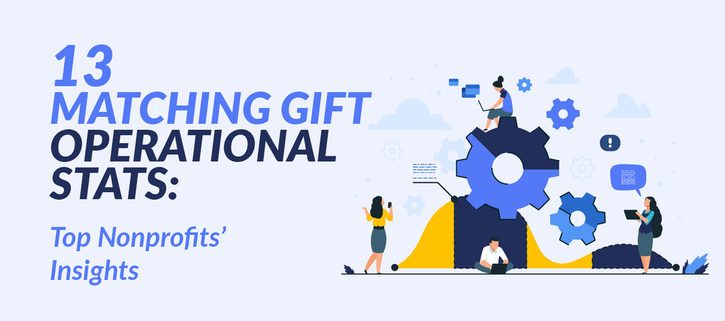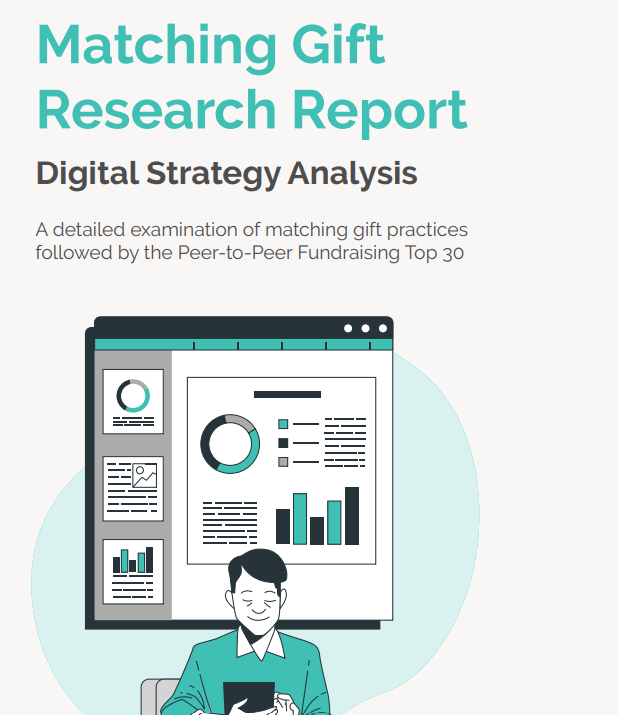13 Matching Gift Operational Stats: Top Nonprofits’ Insights
There are millions of established nonprofit organizations, and the matching gift tactics they employ range from fully built-out strategies to lacking entirely. A recent research report by the Top Nonprofits team shares insights from the leading peer-to-peer focused fundraising groups—specifically focusing on the P2P Top 30.
Here at Getting Attention, we found these findings to be particularly helpful in shedding light on the comprehensive matching gift strategies from some of the most successful organizations overall. That said, we decided to pull a few key matching gift operational stats produced by the study that we’d like to share with you.
General Matching Gift Stats
Before we get started with the Top Nonprofits report, let’s review some general matching gift stats: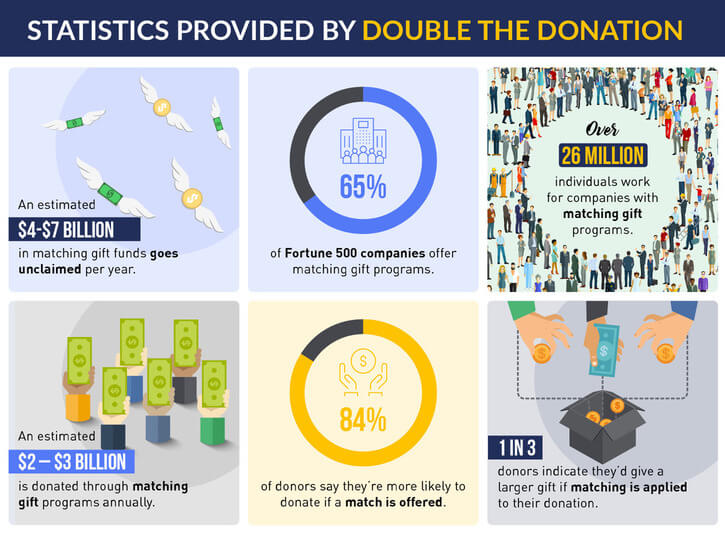
- It’s estimated that $4-$7 billion in matching gift funds goes unclaimed per year. This alarming number is likely due to the fact that many donors and organizations alike don’t know enough about matching gifts and how to determine matching gift eligibility. Therefore, nonprofits miss out on tons of potential funding.
- 65% of Fortune 500 companies offer matching gift programs. More and more employers are starting to realize the extensive benefits that matching gifts provide for all parties involved. Companies and donors get to feel good about the impact they’re making. Meanwhile, nonprofits get more donation revenue that they can put toward serving their mission.
- Over 26 million individuals work for companies with matching gift programs. So many current and potential donors are eligible to have their donations matched. However, matching gift opportunities are not always advertised to donors, leaving nonprofits with a fraction of the donations they could raise.
- An estimated $2-$3 billion is donated through matching gift programs annually. This money can be a game-changer for nonprofits who are strapped for cash or are looking to expand their services. More donation revenue means nonprofits can help more beneficiaries.
- 84% of donors say they’re more likely to donate if a match is offered. Not only are matching gifts a way to increase donation revenue, but they are also effective at getting people to donate in the first place.
- 1 in 3 donors indicate they’d give a larger gift if matching is applied to their donation. Think about the exponential potential for giving that this stat points to. If matching gift-eligible donors contribute more to your organization, then so do their employers. That’s why promoting matching gift opportunities is crucial to increasing donation revenue.
These statistics illustrate how underutilized matching gifts are but also just how vital they can be to nonprofits’ success. Promoting matching gifts to your supporters can help double or even triple the donation revenue your cause receives.
Matching Gift Operational Stats from Top Nonprofits
Now that you understand some of the basic statistics regarding matching gifts, let’s dive into the matching gift operational stats compiled by Top Nonprofits.
1. 100% of the P2P Top 30 organizations employ some sort of matching gift promotion.
The first statistic that we want to note is that of the 30 organizations whose practices were analyzed in the matching gift study, every one of them had some sort of matching gift strategy built into their overall fundraising efforts.
Again, the extent to which matching gifts were incorporated certainly varied from one nonprofit to the next, but all 30 fundraisers mentioned matching gifts in at least one component of their efforts.
2. There is a positive correlation between matching gift strategies and overall fundraising revenue.
This graph from the study lays out the data, showing that nonprofits’ matching gift scores and their overall revenue tended to increase alongside one another.
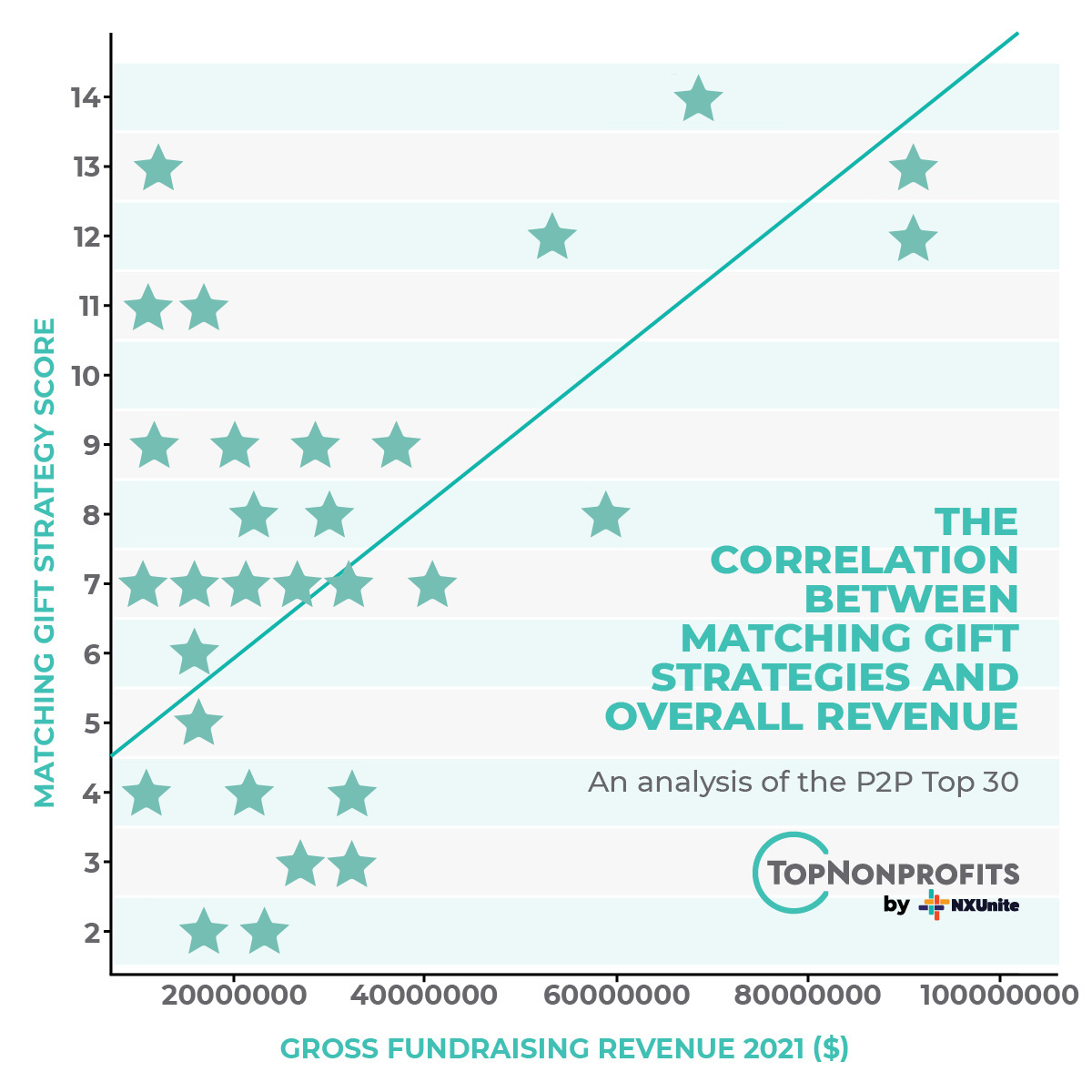
All in all, it can be inferred that organizations with well-thought-out matching gift promotions are more likely to see elevated nonprofit funding. Additionally, those organizations with high levels of fundraising success are more likely to invest in a comprehensive matching gift strategy.
3. The mean matching gift strategy score for the P2P Top 30 falls at 7/14.
For their recent study, the Top Nonprofits team designed a dedicated scorecard to analyze various elements of participating organizations’ matching gift strategies.
Each statement accurately reflecting the organization’s matching gift strategy earns the nonprofit an additional point. The study references the following criteria:
- Hosts a dedicated matching gift page on its website.
- Mentions matching gifts within the donation form.
- Uses an auto-completing company search field.
- Includes matching gift information within the confirmation screen.
- Has an embedded company information widget on the confirmation screen.
- Populates company information widget with employer program details automatically.
- Shares direct links to program guidelines + next steps on the confirmation screen.
- Sends matching gift emails post-transaction.
- Mentions matching gift opportunities in the confirmation email.
- Leverages separate, dedicated matching gift email(s).
- Triggers matching gift emails using the organization’s own domain and branding.
- Links to program guidelines + next steps in follow-up emails.
- Sends matching gift emails within 24 hours of the initial donation being made.
- Uses matching gift software.
Overall, the average matching gift score for the fundraisers included in the project was calculated to be 7/14. This translates to a ‘B’ on the overall grading scale.
Broken down by software provider, the study also notes that the mean score for organizations utilizing Double the Donation software falls at 8.1/14. Meanwhile, Affinaquest’s HEPdata users earned an average of 4.6 points, and organizations using no software (or a still-unknown provider) averaged 3.3/14.
4. Only 6.7% of organizations analyzed with the Top Nonprofits scale earned a perfect score.
(And they all used the same software provider: Double the Donation)
Of the nonprofits analyzed in the study (30 total), only 6.7% (or two organizations) earned a perfect score, having met all fourteen designated criteria on the grading scale.
This means that the vast majority of fundraisers have significant opportunities for improving their matching gift efforts—and can easily do so by pursuing the elements missing in their current strategies.
We did note, however, that both organizations earning full marks employed the same matching gift software—Double the Donation Matching tool.
5. There are 4 primary locations wherein top nonprofits typically promote matching gifts.
Though there were fourteen criteria laid out in the matching gift study, most matching gift promotional efforts can boil down to four overarching opportunities.
This includes an organization’s dedicated matching gift web page, donation forms, confirmation/thank-you screens, and follow-up email communications.
6. 93.3% of top nonprofits have a matching gift page on their website.
Nearly all nonprofits analyzed in the matching gift study currently provide a dedicated matching gift web page on their website. Even those scoring on the lower end of the scale had online matching gift hubs available on their sites.
In fact, this essential asset is one of the key foundations of a healthy overall matching gift strategy. It provides ample information for donors to learn about the opportunity and how they can get involved. Plus, most organizations link to the resource on their confirmation screen, in follow-up emails, and more.
Many of the P2P-based organizations analyzed also host separate event sites for their most prominent fundraising events. Of these groups, some chose to host their matching gift pages on the event-specific website, while others chose to present theirs on the parent organization site, and others still opted for separate match pages on each.
7. 53.3% mention matching gifts within their donation forms.
Mentioning matching gifts within an organization’s donation forms is an excellent opportunity to collect donor employment data. When the form provides context into the why behind employment data inquiries (i.e., to uncover matching gift opportunities), donors are typically happy to oblige.
And according to the matching gift promotions analysis, more than half of the organizations in the study integrated this tip into their practices.
Like just about every other aspect of nonprofit matching gift marketing, the ways in which they did so differed. This ranged from short and sweet labels marking the optional data fields for employer matching information to summaries of matching gifts and the benefits that come with program participation.
8. 83.3% highlight matching gifts on their confirmation screens.
Following the donation form itself is typically a gift confirmation screen. And according to the study, the majority of leading nonprofits use this chance to promote matching gifts. However, the extent of the confirmation page promotional efforts varies widely.
For example, some organizations offered single-sentence mentions that encouraged donors to pursue the opportunity on their own. The fundraiser may prompt individual donors to contact their company’s HR department to find out if their employer participates.
However, other nonprofits took a more advanced approach. These teams provided company-specific program guidelines and eligibility criteria and even direct links to online submission forms. This allows the donor to kick off the matching gift process from the initial thank-you screen with just one click!
While the former is better than lacking matching gift mentions altogether, the latter technique really works to simplify matching gifts for donors and ultimately aims to drive more matches to completion.
9. 16.7% do not include matching gifts on their donation forms or their confirmation screens.
Not including this information ultimately means that the fundraisers do not have an easy way to collect employment information during the giving process, nor do they offer instant next steps after an individual submits their gift.
This could cause an organization to miss out on available matching gifts. Because remember: more than 26 million individuals work for companies that offer matching gift initiatives. Yet 78% of the match-eligible segment has no idea that they qualify for such a program.
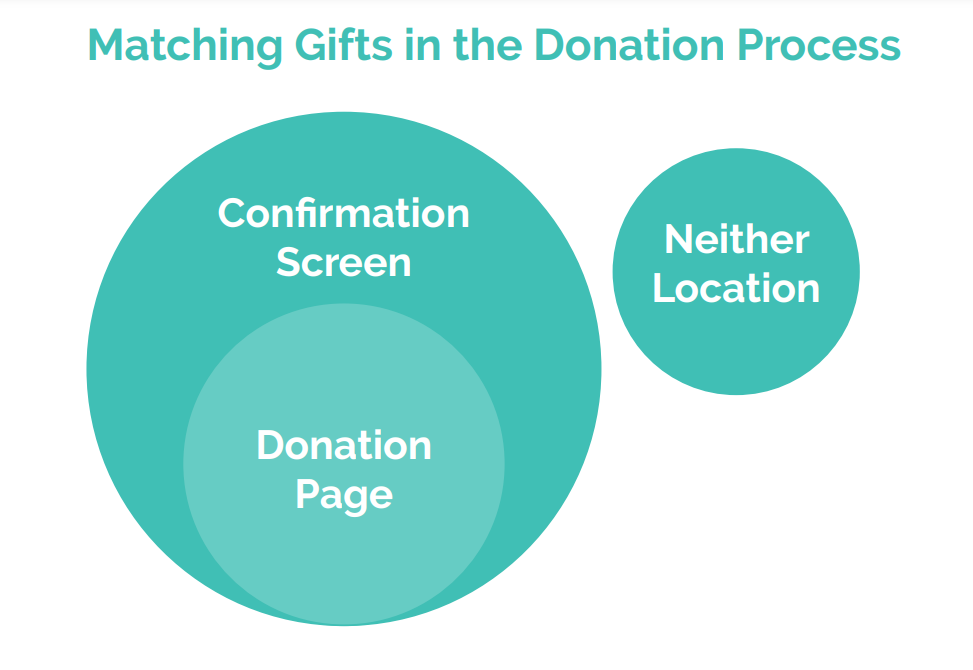
For nonprofits that fall into this group, incorporating matching gifts within the giving experience—either directly within, immediately afterward or, in the best of both worlds, both locations—is a quick and impactful way to ramp up matching gift marketing.
10. 86.6% enlist follow-up emails to remind donors about matching gift opportunities.
Once the donation process itself is complete, most organizations took the time (or, more likely, triggered automation) to follow up with donors regarding matching gifts. These typically fell into one of two categories:
- Mentions of matching gifts within a more general confirmation or acknowledgment email
- Dedicated, separate email focused on matching gift opportunities and how to get involved.
According to the study, however, not all follow-ups necessarily hold the same value. In fact, the report outlines tips and tricks for creating optimized matching gift messages, which include using the organization’s own email domain and branding, personalizing the contents with employer-specific information, and more. And the most strategic nonprofits utilize emails that provide direct links to the recipients’ online submission portals, empowering donors to launch the matching gift process right from the email.
11. 10% highlight matching gifts in confirmation emails and separate follow-up messages.
Though 86.6% of organizations follow up with donors about matching gift opportunities post-transaction (using some combination of confirmation emails that highlight matching gifts and separate matching gift messaging), only 10% of participating nonprofits incorporated matching gifts in both types of email communications.
Why does this matter? Well, the more opportunities a donor has to be informed and reminded about matching gifts, the higher the chances are that they complete their end of the matching process. Another common roadblock among fundraisers that enlist only confirmation emails to mention matching gifts is that donors are more likely to skim and discard the message without the reader even getting to the part about matching gifts. That’s a missed opportunity for donors and nonprofits alike!
12. Of those that send matching gift emails post-transaction, 52% do so within 24 hours of donors first contributing.
Another finding we saw in the study is that when it comes to following up on match-eligible donations, timeliness matters. In fact, one of the key criteria included in the matching gift scorecard asks whether the organization sends matching gift emails in the first 24 hours after the initial donor contributes.
And of the organizations that have enlisted matching gift emails, more than half do, in fact, meet this standard. The report even highlights that many organizations’ triggered their first matching emails within minutes of the donor clicking “submit” on their gift!
Not to mention, a separate compilation of matching gift operational stats from Double the Donation indicates that match reminder emails sent within 24 hours of an initial donation result in a 53% open rate. That’s more than 2-3 times higher than the average nonprofit email open rate—inferring that donors are more likely to engage with the content when sent in a timely manner.
13. 73.3% of the Top 30 organizations use Double the Donation’s tools.
Organizations analyzed within the Top Nonprofits study of the P2P Top 30 can be divided into four categories based on software usage.
At the time of the report, 73.3% employ Double the Donation’s matching gift automation solution, Double the Donation Matching. Meanwhile, 16.7% use HEPdata tools, and 3.3% use Amply software. The remaining 6.7% of organizations did not seem to use any dedicated matching gift tools.
The following chart from the report helps visualize the findings:
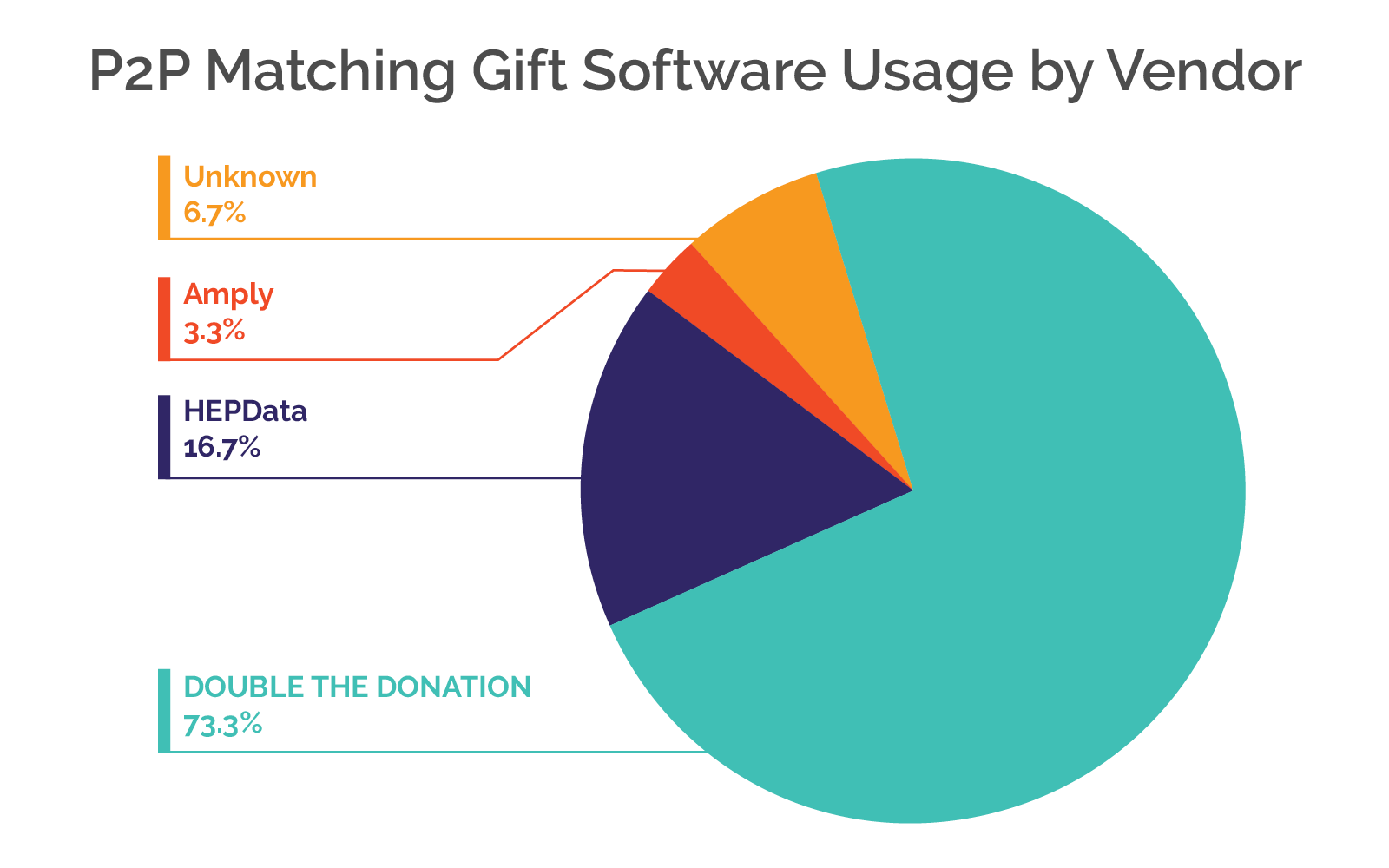
So what does this finding imply? More top-earning nonprofit fundraisers are trusting Double the Donation to empower their matching gift efforts than any other provider.
Not to mention, Double the Donation users scored more highly on the matching gift score chart overall compared to users of alternative software solutions.
Wrapping Up
By analyzing the matching gift operational stats of top nonprofits, we can gain insights into best practices to follow and make a note of emerging trends in matching gift fundraising. From there, organizations like yours can learn from others’ successes and identify growth opportunities—then pursue those areas more effectively.
Interested in learning more about top matching gift strategies and best practices? Check out these additional resources to dive deeper:
- The Matching Gift Research Report [From Top Nonprofits]. Check out the full study here! We referenced some of our favorite matching gift operational stats in this guide. However, the complete research report shares in-depth analysis of thirty leading nonprofit fundraisers that you won’t want to miss.
- 14 Important Matching Gifts Questions You Need to Ask. Got questions? We have answers. Explore the basics of corporate matching gifts and how to leverage the opportunity for your team in this guide. The more you know, the better you can optimize your nonprofit’s efforts to drive results.
- 19 Matching Gift Companies with Impactful Programs. Get familiar with some of the most prominent matching gift programs and see if your donors work for these companies. View guidelines and initiatives for employers like General Electric, Coca-Cola, Home Depot, and more.
